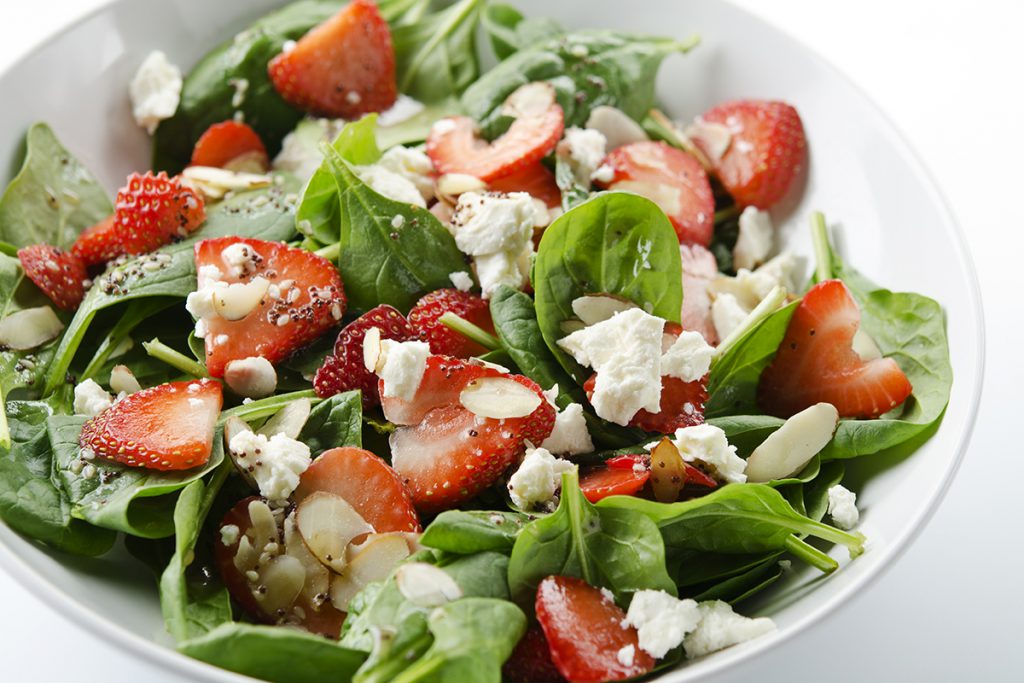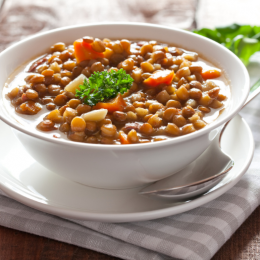4 combinaciones de alimentos para aumentar la absorción de nutrientes
Put these power couples on your plate to help your body better absorb key vitamins and minerals.

Some things are just better together. Chocolate and peanut butter are each delicious on their own, for instance. But combined? They make magic.
Sitting down to a hearty bowl of lemony lentil soup or enjoying a dinner of salmon and roasted broccoli might not be as fun as dunking a square of chocolate into a jar of peanut butter, but they are prime examples of how combining certain foods can amp up the power of the nutrients contained in each one.
“There’s a reason why nutrition experts promote a balanced, varied diet,” says Trinique Waters, L.D.N., a registered dietitian based in Philadelphia and president-elect of the Philadelphia Academy of Nutrition and Dietetics. “It’s because we get benefits from different compounds in different foods. It’s not necessary to always pair certain foods together, but to get the most benefits, it is helpful to combine certain ones, especially if you’re deficient in a particular nutrient.”
Read on for four power couples to consider.
Nutrient Power Couple #1: Broccoli Rabe and Salmon
Calcium and vitamin D
Calcium gets all the credit when it comes to strengthening bones. But it needs a partner to get the job done well: vitamin D.
“Most of the calcium in food is in an inactive form and needs vitamin D to be converted to the active form,” says Megan Meyer, Ph.D., senior director of science communications for the International Food Information Council.
The human body can make vitamin D on its own when sunlight hits the skin - that's why it's called "the sunshine vitamin." But as Waters points out, "We have been inside our houses more than ever in the past two years. And if we're not getting enough vitamin D, it's difficult for calcium to be absorbed into our bones."
A handful of foods naturally contain vitamin D, including:
- Fatty fish, such as salmon, tuna and mackerel
- Mushrooms
- Egg yolks
Other items, like cow’s milk and various plant-based milks, are fortified with vitamin D. And orange juice is often fortified with both calcium and vitamin D.
Broccoli rabe, collard greens, kale, and bok choy all make a tasty, calcium-rich pairing with fish, but they’re not the only options. Here are a few more calcium and vitamin D combos to try:
- Tofu and mushroom stir-fry
- A cheese board and sardines
- White beans and tuna fish
Nutrient Power Couple #2: Spinach and Strawberries
Plant-based iron and vitamin C
Waters was recently counseling an older vegetarian client with low iron levels — a common occurrence in people who are not meat eaters, since meat is very high in iron. The deficiency was concerning because iron has a couple of important jobs: It helps carry oxygen from the lungs throughout the entire body so that cells can produce energy, and it’s also needed to make certain hormones.
Leafy green vegetables are high in iron, but it's a type of plant-based iron called nonheme iron, which isn't easily absorbed by the intestines. (Iron in animal products, such as beef, poultry, and seafood, is called heme iron and is better absorbed by the body.)
Pairing nonheme iron with vitamin C can boost absorption, according to research published in 2020 in the Journal of Nutrition and Metabolism. That’s why Waters suggested that her client add vitamin-C-rich strawberries (or any citrus fruit) to her spinach salads. In addition to leafy greens, whole grains like quinoa and oatmeal are also good sources of nonheme iron, as are iron-fortified breakfast cereals — all of which would be tasty with strawberries on top.
Not a big fan of strawberries? Here are more nonheme iron and vitamin C pairings:
- Quinoa and red bell pepper
- Baked potato and roasted broccoli
- Avocado and tomatoes on whole-grain toast or a bed of spinach
- Lentil soup and a squeeze of lemon juice
Nutrient Power Couple #3: Kale and Olive Oil
Vitamin K and healthy fat
Leafy greens like kale, spinach, collard greens, and Swiss chard are rich in vitamin K, a nutrient that plays a crucial role in blood clotting and bone health, Waters says. But like other fat-soluble vitamins (A, D, and E), it needs a little boost from fat to be absorbed by the body.
In a small study published in the American Journal of Clinical Nutrition, women ate salads with varying amounts of added fat in the form of soybean oil. Then they had their blood tested to measure how well they absorbed various nutrients in the salad. The more oil they consumed (up to a little more than 2 tablespoons), the more nutrients they absorbed, including vitamins K, E, and A.
This doesn’t mean you should drench your salads in dressing, but it does make a case for confidently drizzling up to 2 tablespoons of heart-healthy olive oil onto salads or into a pan before sautéing your greens.
Suscríbase a nuestro boletín informativo
Es rápido y fácil: Usted podría estar entre las 13 millones de personas elegibles.
¿Ya es miembro? Haga clic para descubrir nuestros más de 15,000 centros participantes.
Síganos
More leafy greens and healthy fat pairings:
- Spinach or kale and avocado (as a salad or on a sandwich)
- Peanut oil–braised collard greens
- Arugula and salmon
Nutrient Power Couple #4: Your Favorite Yellow Curry and Black Pepper
Curcumin and piperine
Turmeric is a traditional Indian spice with an earthy-peppery taste that's often used in curry dishes. The key active chemical in turmeric is curcumin, which gives the spice its deep yellow-orange color and has powerful antioxidant and anti-inflammatory properties.
Research suggests that a regular intake of curcumin can improve symptoms of anxiety, depression, and arthritis, among other things, says Mariana Dineen, M.S., a Chicago-based registered dietitian and founder of Pretty Nutritious. “The problem is that curcumin is not very well absorbed by our bodies,” she says.
It helps to consume it with black pepper, which contains the active ingredient piperine. Piperine helps curcumin pass through the intestinal lining and into the bloodstream. In fact, adding piperine can increase the bioavailability (the degree and rate at which your body absorbs a substance) of curcumin by 2,000 percent, according to a study in the journal Planta Medica. That’s why many curcumin supplements also contain piperine.
To get the benefits without supplements, crack some black pepper on your favorite yellow curry dish. Or try these curcumin and piperine pairings:
- Veggies roasted with turmeric and black pepper
- Eggs sprinkled with turmeric and black pepper
- A golden milk latte (2 cups steamed unsweetened plant-based milk, 2 teaspoons honey, 1 teaspoon turmeric, ½ teaspoon cinnamon, ½ teaspoon ground ginger, ½ teaspoon vanilla, pinch of black pepper)
Just getting started with the Make Your Move Challenge? Find this week’s featured 10-Minute Flexibility and Mobility Workout here. And keep up with the challenge here.
¡Tome en línea sus clases favoritas de SilverSneakers!
SilverSneakers members can access live fitness classes and wellness workshops through SilverSneakers LIVE. See the latest schedule and RSVP for classes here.
¿No es miembro? If you have a Medicare Plan, it may include SilverSneakers — at no additional cost. Check your eligibility instantly here.





